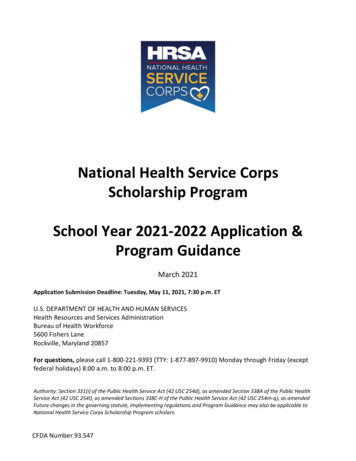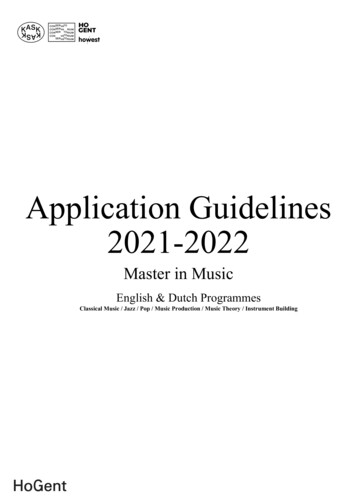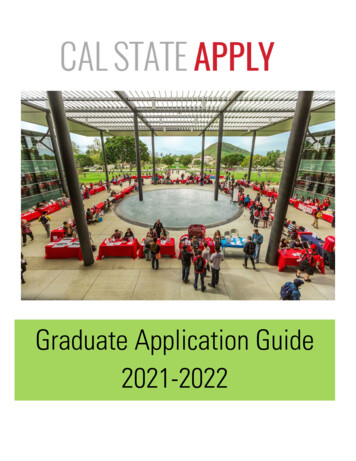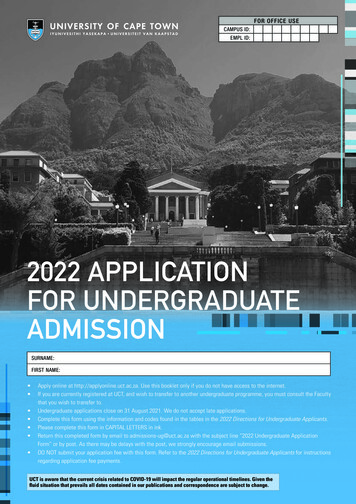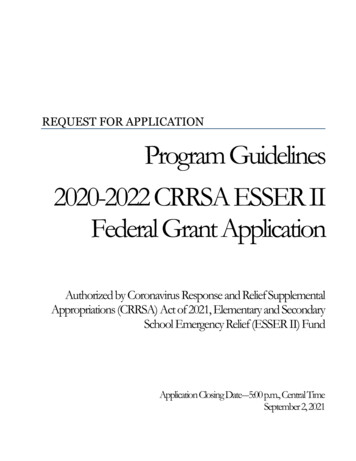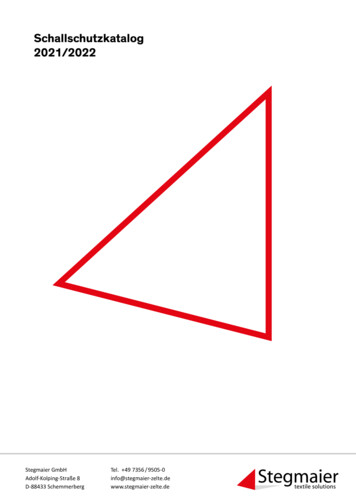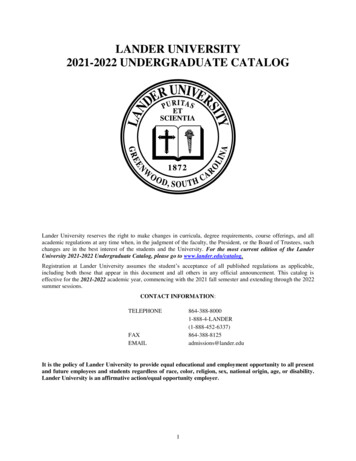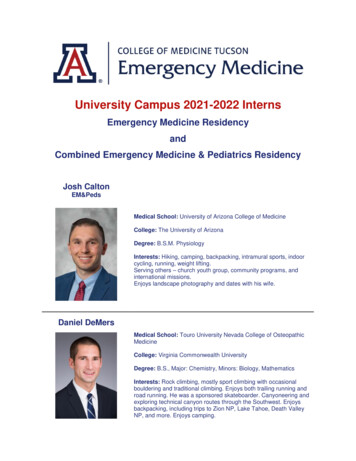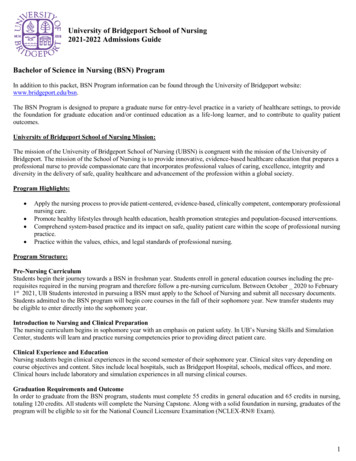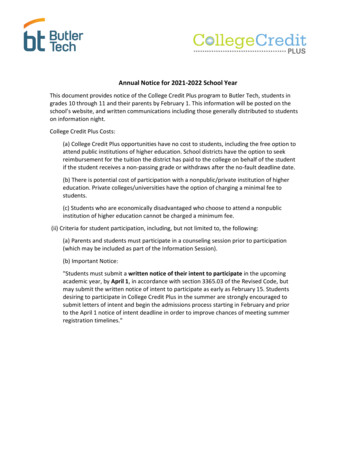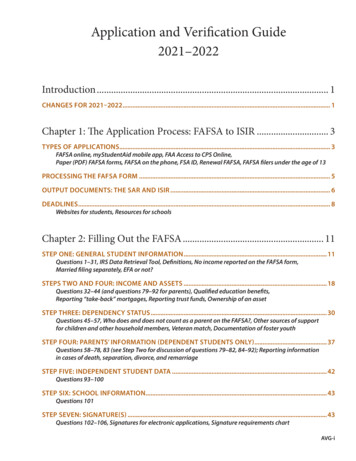
Transcription
Application and Verification Guide2021–2022Introduction. 1CHANGES FOR 2021–2022. 1Chapter 1: The Application Process: FAFSA to ISIR. 3TYPES OF APPLICATIONS. 3FAFSA online, myStudentAid mobile app, FAA Access to CPS Online,Paper (PDF) FAFSA forms, FAFSA on the phone, FSA ID, Renewal FAFSA, FAFSA filers under the age of 13PROCESSING THE FAFSA FORM. 5OUTPUT DOCUMENTS: THE SAR AND ISIR. 6DEADLINES. 8Websites for students, Resources for schoolsChapter 2: Filling Out the FAFSA. 11STEP ONE: GENERAL STUDENT INFORMATION. 11Questions 1–31, IRS Data Retrieval Tool, Definitions, No income reported on the FAFSA form,Married filing separately, EFA or not?STEPS TWO AND FOUR: INCOME AND ASSETS. 18Questions 32–44 (and questions 79–92 for parents), Qualified education benefits,Reporting “take-back” mortgages, Reporting trust funds, Ownership of an assetSTEP THREE: DEPENDENCY STATUS. 30Questions 45–57, Who does and does not count as a parent on the FAFSA?, Other sources of supportfor children and other household members, Veteran match, Documentation of foster youthSTEP FOUR: PARENTS’ INFORMATION (DEPENDENT STUDENTS ONLY). 37Questions 58–78, 83 (see Step Two for discussion of questions 79–82, 84–92); Reporting informationin cases of death, separation, divorce, and remarriageSTEP FIVE: INDEPENDENT STUDENT DATA. 42Questions 93–100STEP SIX: SCHOOL INFORMATION. 43Questions 101STEP SEVEN: SIGNATURE(S). 43Questions 102–106, Signatures for electronic applications, Signature requirements chartAVG-i
Chapter 3: Expected Family Contribution (EFC). 47GENERAL INFORMATION. 47SIMPLIFIED FORMULA. 47AUTOMATIC ZERO EFC.48DEPARTMENT OF DEFENSE MATCH AND IRAQ AND AFGHANISTAN SERVICE GRANT. 49ALTERNATE EFCS. 49THE EFC WORKSHEETS.49Negative AGI or zero?FORMULA A—DEPENDENT STUDENTS. 50Parents’ contribution, Student’s contribution from income, Student’s contributionfrom assets, Calculation of student’s EFC , Alternate EFCs for other than nine-month enrollmentFORMULA B—INDEPENDENT STUDENT WITHOUT DEPENDENTSOTHER THAN A SPOUSE . 54Contribution from available income, Contribution from assets, Calculation of student’s EFC , AlternateEFCs for other than nine-month enrollmentFORMULA C—INDEPENDENT STUDENT WITH DEPENDENTSOTHER THAN A SPOUSE . 56Available income, Contribution from assets, Calculation of student’s EFC, Alternate EFCsfor other than nine-month enrollmentChapter 4: Verification, Updates, and Corrections. 59REQUIRED POLICIES AND PROCEDURES. 59Verification selection and PJAPPLICATIONS AND INFORMATION TO BE VERIFIED. 60School-selected verification, Verification tracking groups, Changing tracking groups,Reporting results for groups V4 and V5, Verification exclusions, Verification following disasters,Higher Education Relief Opportunities for Students (HEROES) ActDOCUMENTATION. 65Documenting AGI, taxes paid, and other tax data with the DRT; Using a joint return to figure individualAGI and taxes paid; Using the tax transcript; Rollovers and verification; Using the tax return; If a W-2 isnot available; Immigrants and tax filing; Special situations; Household size; Number in college; Highschool completion; ATB alternatives for high school completion; Identity and statement of educationalpurposeINTERIM DISBURSEMENTS. 79Overpayments from interim disbursements, Schools that can’t make interim disbursementsUPDATING INFORMATION. 80Parent remarriage after applyingAVG-ii
CORRECTING ERRORS. 81CHANGES IN A SELECTED APPLICANT’S FAFSA. 81Campus-based and Direct Loan changes, Pell changes, Selection after disbursement,Disbursing unsubsidized aid, After documentation is completeHOW TO SUBMIT CORRECTIONS AND UPDATES. 82Using the online FAFSA, Submitting changes via FAA Access to CPS Online or EDE,Using the SAR to make corrections, Adding schools and changing a student’s address,SignaturesDEADLINES AND FAILURE TO SUBMIT DOCUMENTATION. 84Campus-Based and Direct Loan, Pell Grants, Other considerations, Late disbursements,Verification status codesSUGGESTED VERIFICATION TEXT. 86Chapter 5: Special Cases. 87PROFESSIONAL JUDGMENT. 87Entire text of the HEA section on PJ, Dependent students without parent support,Refusing or reducing a loanDEPENDENCY OVERRIDES. 91Unable to provide parent data, Overrides and professional judgmentCONFLICTING INFORMATION. 93Subsequent ISIRs, Discrepant tax data, Marital and tax filing status,Resolution of conflicting informationREFERRAL OF FRAUD CASES. 95OIG address and phone numbers, Reporting Fraud Rings (Distance Education), FSA Feedback CenterUNACCOMPANIED HOMELESS YOUTH. 96Confirmation not required, Homeless youth definitionsAVG-iii
IntroductionaThis guide is intended for college financial aid administrators andcounselors who help students begin the aid process—filing the FreeApplication for Federal Student Aid (FAFSA ) form, verifying information, and making corrections and other changes to the information reported on the FAFSA.Throughout the Federal Student Aid Handbook we use “college,” “school,”and “institution” interchangeably unless a more specific use is given.Similarly, “student,” “applicant,” and “aid recipient” are synonyms. “Parents”in this volume refers to the parents of dependent students, and “you” refersto the primary audience of the Handbook: financial aid administrators atcolleges. “We” indicates the U.S. Department of Education (the Department,ED), and “federal student aid” and “Title IV aid” are synonymous terms forthe financial aid offered by the Department.We appreciate any comments that you have on the Application andVerification Guide, as well as all the volumes of the FSA Handbook. Werevise the text based on questions and feedback from the financial aid community, so please write us at fsaschoolspubs@ed.gov about how to improvethe Handbook so that it is always clear and informative.Notes on Active LinksAt the top of each page you will find links to the Handbook glossaryand acronyms, the Code of Federal Regulations, and Dear Colleague Letters.Glossary CFR DCLChanges for 2021-2022On the bottom of page 3 we provided additional information where students can obtain and download the myStudentAid app.We added the definition of a valid ISIR or SAR on page 7.Throughout chapter 2, all dates and pertinent tax return and scheduleinformation have been updated to conform to the requirements associatedwith the 2021-2022 processing year and the 2019 base tax year.On page 15 we provided new information pertaining to the DRT’s abilityto automatically answer the question about whether or not a tax filer fileda Schedule 1, including current exceptions.FSA HB January 2021AVG–1
Application and Verification Guide 2021-2022On page 48 we increased the income threshold for the automatic zeroEFC consideration to 27,000.In chapter 3 we removed the EFC calculation worksheets and tables fromthe end of the chapter and instead refer individuals to the 2021-2022 EFCFormula Guide.We added a sentence on page 63 reminding schools that when reportingcorrections for V4 or V5 outcomes in FAA Access to CPS Online, the latestoutcome results will supplant any previously reported outcome results.We provided examples of acceptable signatures for paper and electronictax returns on page 70.On page 74 we clarified that an IRS Request Flag value of 07 will bereturned if the tax filer or the IRS amends a tax filer’s return.On page 78 we added a definition of a valid unexpired governmentissued photo ID for identity proposes including the exclusion of military IDs.In Chapter 4, we removed the section discussing paper FAFSA corrections by phone with the Federal Student Aid Information Center (FSAIC) asthat functionality was removed from FSAIC a couple of years ago.We removed the suggested text from the end of Chapter 4 and insteadrefer individuals to the appropriate electronic announcement to review thesuggested text for the 2021-2022 processing year.In chapter 5 we added clarifying guidance on page 89 indicating that aschool cannot perform professional judgement for a student after that student ceases to be eligible, including when the student is no longer enrolled.On page 95 we added the new fraud ring reporting procedures schoolsneed to follow when communicating with the Inspector General’s Office.AVG–2FSA HB January 2021
Glossary CFR DCLThe ApplicationProcess: FAFSA to ISIRaCHAPTER1The laws governing the Federal Student Aid (FSA) programs require that a personapply for aid with a form provided by the U.S. Department of Education (ED) and thatno fee be charged for processing it. This is the Free Application for FederalStudent Aid (FAFSA ) form.To be considered for federal student aid, a student must complete aFAFSA form. It collects financial and other information used to calculatethe expected family contribution (EFC) and to determine a student’s eligibility through electronic database matches with other agencies.The FAFSA form is the only form students must fill out to apply for TitleIV aid. A school cannot require extra information from students except forverification or resolution of conflicting information. However, a school mayrequire additional information for other purposes, such as packaging privateor institutional aid. If the school collects additional information that affectsTitle IV eligibility, it must take the information into account when awardingTitle IV aid.TYPES OF APPLICATIONSMost FAFSA forms are filed electronically, but there are other options.FAFSA onlineStudents, parents, and preparers can complete an application online andsend it directly to the Central Processing System (CPS). They can also correct previously submitted data that was not imported from the IRS. Help isavailable for students online or by calling the Federal Student Aid Information Center (FSAIC) at 1-800-4-FED-AID (1-800-433-3243). To make usingthe Web application easier, ED produces the FAFSA on the Web worksheet,which can be printed from the StudentAid.gov website.myStudentAid mobile appAnother way to apply is through the FAFSA feature of the myStudentAid mobile app, which is the FAFSA filing component of the myStudentAidapp for mobile devices. Students, parents, and preparers may use it to begin,complete, and/or submit a new or renewal FAFSA. The myStudentAid app isavailable on the App Store (iOS) or on Google Play (Android). Help is available in the app or by calling the FSAIC.FSA HB January 2021AVG–3
Application and Verification Guide 2021-2022Glossary CFR DCLFAA Access to CPS OnlineYou can submit a student’s application data at FAA Access to CPSOnline. You can also connect to the site through EDExpress.Before submitting the data, print the signature page/FAFSA summaryfor the student (and parent if appropriate) to sign, or have the student fillout and sign a paper FAFSA form. As noted at the end of Chapter 2, youwill need to retain either the signed signature page/summary or signedFAFSA form for your records, even if the student doesn’t receive aid or attend your school.Paper (PDF) FAFSA FormMore than 99% of applications are filed electronically, so the only paperoption is the PDF FAFSA form, which students can get at studentaid.gov.They can print the PDF and fill it out by hand, or they can type their dataon the PDF before printing and mailing it. If needed, they can request singlecopies from the FSAIC by calling 1-800-433-3243.Other than these limited paper FAFSA form options, FSA no longerprints or mails aid-related publications, though they are available online forusers to download and print. For more information on electronic versions ofpublications, fact sheets, online tools, and other resources, please go to FinancialAidToolkit.ed.gov/resources and/or StudentAid.gov/resources.Applying electronically is better than using the paper FAFSA form because of the following advantages: faster processing; the availability of onlinehelp; skip logic, which allows applicants to skip over questions that don’tpertain to them; and fewer errors and rejected applications because internaland end-of-entry data edits ensure that required fields are completed andconflicts are resolved prior to submission.FAFSA on the phoneStudents who have limited or no Internet access and face pressingdeadlines can choose to complete and submit their application by calling1-800-433-3243, telling a representative they would like to complete theirFAFSA form over the phone and providing their information. This typicallytakes about half an hour. Students will receive a paper student aid report(SAR) 7–10 days later, which they (and their parents, if appropriate) mustsign and return. Because this is not the preferred method to apply for aid, itshould be used sparingly and only by those students identified previously.FSA IDStudents use the FSA ID to log on to the FAFSA online and other FSAwebsites with a username and password they create. An FSA ID is alsoneeded for students, parents, and preparers to use the FAFSA feature of themyStudentAid mobile app. Parents and students can electronically sign theFAFSA form but must do so with their own FSA ID. A verified email address or cell phone number can be used instead of the username. See theannouncement of May 16, 2019, for recent information. Users can create anFSA ID online.AVG–4FSA HB January 2021
Glossary CFR DCLChapter 1—The Application Process: FAFSA to ISIRRenewal FAFSAA student who has received an FSA ID and who the year before had anISIR with a successful match on Social Security number (SSN), name, anddate of birth with the Social Security Administration (SSA) is eligible for arenewal FAFSA form. When the student logs in to the electronic FAFSAform, he or she will be asked if he or she wants to pre-fill some of the application with data from the prior year. By choosing this option, the student canreview each pre-filled item, update any that have changed, and provide newinformation as needed. If an aid administrator’s school does not appear onthe renewal application, he or she can use the student’s data release number(DRN) to access the application in FAA Access to CPS Online.In October–November 2020, students with a valid email address in theCPS who submitted FAFSA information for 2020–2021 and had not yet doneso for 2021–2022 received an email encouraging them to complete the newapplication early. For more information see the October 22, 2020 electronicannouncement. In addition, in January–February 2021, renewal eligiblestudents who still have not submitted 2021–2022 FAFSA information willreceive a renewal reminder as in previous years.Because students from Palau, the Marshall Islands, and Micronesia,known collectively as the Freely Associated States, are not eligible for an FSAID (for lack of an SSN), they cannot pre-fill data in the online FAFSA form.But an FAA can use FAA Access to CPS Online to enter renewal applicationsfor these students if they meet the renewal application eligibility requirements.FAFSA filers under the age of 13Because the Children’s Online Privacy Protection Act (COPPA) of 1998prohibits any entity, including a government agency, from electronically conducting business or communicating with a person under age 13, applicantswho are 12 or younger cannot complete the FAFSA online. Instead, whenthey apply for financial aid, they or a parent or legal guardian, financial aidadministrator, or high school counselor can complete the appropriate awardyear PDF FAFSA and mail it to:Federal Student Aid ProgramsAttn: COPPA/CORR Process Building 11084 South Laurel RoadLondon, KY 40744Such applicants are not to provide an email address on the application orwith any correction that might follow. After the FAFSA is submitted, it willbe processed and a paper SAR will be sent to the student and a regular ISIRwill be sent to schools. See the August 4, 20
and acronyms, the Code of Federal Regulations, and Dear Colleague Let-ters. Changes for 2021-2022 On the bottom of page 3 we provided additional information where stu-dents can obtain and download the myStudentAid app. . This is the
